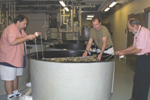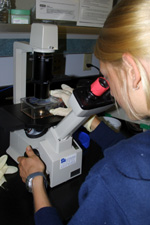Marine research connected to human health
by Heather WoolwinePublic Relations
As the research horizon expands at MUSC and beyond, quick-moving waves of understanding lap against the shore of human health.
 Matt Jenny, Marine
Biomedicine & Environmental Sciences, from left, Drs. Charlie
Cunningham and Greg Warr lift oysters out of a tank for inspection.
Matt Jenny, Marine
Biomedicine & Environmental Sciences, from left, Drs. Charlie
Cunningham and Greg Warr lift oysters out of a tank for inspection. Creatures of the sea are now in a position to tell us more than ever about themselves, and us too. Researchers at the Hollings Marine Lab and the Strom Thurmond/Gazes research facility are gaining insight about human function through the likes of oysters, dolphins, shrimp and coral.
By looking at oyster disease resistance or dolphin tissue samples, scientists can begin to understand how animal tissue reacts to particular environmental stressors, and thus predict how human tissues might react as well. To look at the concept in larger terms, think of it this way: if scientists can look at a stressor, say a pollutant in the water, and determine how it affects gene function within an animal, then that scientist could determine how humans might react when exposed to the same stressor.
 Dr. Charlie
Cunningham
Dr. Charlie
CunninghamEnter Charlie Cunningham, Ph.D., the Hollings Marine Lab’s Ernest F. Hollings Visiting Scholar, a member of the MUSC Biochemistry faculty and an expert in cell and molecular biology. “Prior to coming to this lab, I wrote three or four papers in Norway about oyster development and immunity,” Cunningham said. “And a huge issue that I ran into was that I was working with a non-classical animal model, so because I didn’t have the tools readily available to me, our science wasn’t progressing as quickly as it would have with a classical animal model such as the mouse.” Three years later, Cunningham left the Sars International Centre for Marine Molecular Biology in Bergen Norway for a chance to study at the Hollings Marine Lab. “There are many strengths here. There’s not only a collection of like-minded scientists with the same basic interests but the facilities and equipment are cutting edge. Add to that the high quality of graduate students and technical staff that work here and you have a superb environment for advanced study.”
 A technician at the
Hollings Marine Lab dissects an oyster for further study.
A technician at the
Hollings Marine Lab dissects an oyster for further study.Enhanced by the exceptional state-of-art facilities, lab space, and technology that the Hollings Marine Lab offers, Cunningham’s research with oysters is set to take off thanks to huge strides in producing gene chips or “microarrays.”
Microarrays are a new technology that allows scientists and researchers to arrange and review thousands of gene expression patterns at one time, versus the old method of one at a time.
Needless to say this new technology catapults Cunningham’s work with oysters forward. “Microarrays can be applied to any species so the possibilities are quite incredible,” Cunningham said. “It’s a giant leap forward. Now we have the technology to see the changes in gene expression in relation to an environmental stressor so all that’s left to understand why they react they way they do.”
Greg Warr, Ph.D., MUSC Biochemistry professor, whose lab is in the Hollings Marine Lab, felt that the combination of technology, facilities, and staff is what is drawing scholars like Cunningham to Charleston.
The Hollings Marine Lab is not just MUSC space, indeed, four other entities share research and work space; namely, the National Oceanic and Atmospheric Administration (NOAA), the National Institute of Standards and Technology, South Carolina Department of Natural Resources (SCDNR), and College of Charleston. Much of the funding for the lab and its occupants comes from the federal government, who actually owns the building with major contributions from the four other partners. Through a joint project agreement, the different agencies contribute and collaborate with a unified mission of exploring the relationship between the ocean environment and human health. In fact, NOAA operates one of three of its nationally designated centers of excellence, Center of Excellence for Oceans and Human Health, at the Hollings Marine Lab.
It’s this mission of exploring the relationship of the ocean with human health that weds a researcher like Cunningham with a specific molecular research focus with so many multidisciplinary scientists in one place.
“The connection between the ocean environment and human health goes beyond looking at human disease and the quality of our seafood,” Warr said. “A clean and functional marine environment relates to many aspects of human health and quality of life through economics, aesthetics, as a food source, and as a source of recreation. If that environment is degraded, our health and lives are affected in many ways, but most people still have difficulty seeing it in a global manner. The United Nations published a detailed report on marine environments and how these ecosystems perform services, like how marshes filter water. Healthy ecosystems are the basis for many human activities.”
So where does Cunningham’s study of the oyster fit in? Aside from its well-known spot in the food chain, “oysters have several roles in the environment, all related to human health,” Cunningham said. “First, they are filter feeders so their health is a pretty good indicator of the overall health of an ecosystem. When they are healthy, they in turn maintain the coastline’s health. This is best illustrated with the demise of the Chesapeake Bay. The oyster population there filtered that entire body of water every few days but because the water was so polluted from run-off sewage, human activities, and changes in salinity, they because distressed as the whole health of the Bay decreased. There is now little to no hope that the Bay will ever recover.”
 Blake Ellis,
College of Graduate Studies, examines a portion of a dolphin skin cell
culture.
Blake Ellis,
College of Graduate Studies, examines a portion of a dolphin skin cell
culture.Of course most people are familiar with the fact that polluted waters provide an environment in which bacteria infect oysters. People who consume infected oysters usually become severely sick, sometimes leading to organ failure or death.
In terms of the economy, when oyster beds are lost to disease or another environmental stressor, the resulting consequences are catastrophic for those who make their living harvesting oysters.
“The individual health of oysters and how they respond to disease can be early warning signs that a marine ecosystem is stressed, and thus some aspect of human health may also be in danger,” Warr said. “We’re very good at measuring differences between pristine and degraded environments, but we’re not as good yet with identifying the early warning signs of ensuing degradation. The research that is conducted at the Hollings Marine Lab will help identify how organisms react to their environment just when things are beginning to go wrong, instead of when it’s too late.”
Researchers on the Fort Johnson campus are excited and interested in applying the new functional genome technology, microarrays, to measure the health of oysters, dolphins, shrimp and coral in coastal environments. Warr and Cunningham also see a direct medical connection to human health. Studying the basics of oyster gene expression and immunologic responses to stressors and disease can provide a new model for scientists wishing to learn more about human immunologic response to the same stressors. Not to mention that oysters are a relatively unstudied group of the animal kingdom that may open doors of understanding in terms of evolution of many species.
“By looking at the oyster from an evolutionary point of view, this invertebrate might be able to give us more insight into vertebrates by making us take a step back to understand how basic immunity functions,” Cunningham said. “There have already been discoveries within invertebrates that have led to new understanding and discovery with vertebrates.”
Cunningham and Warr are quick to point out that all of the data and information goes no where though without the help of people who can analyze it. “We are so lucky to have great bio-statisticians who can take the information from the microarrays and all of the historical data, like water temperatures and pesticide levels, and bring all of that information together to create predictive data that means a lot to the public health community as well as those with economic concerns,” Cunningham said. “Hopefully, about five years from now people can take simple measurements and know how the oyster population is doing and predict how well it will do for that year. Hopefully with predictive information, decisions that affect ecosystems can be planned and executed with greater thought and care.”
Warr said that ecoforecasting, or predications made about the environment’s future, is another potential application of the oyster research going on a Hollings Marine Lab. He also mentioned that another scientist at the a Hollings Marine Lab., Robert Chapman, Ph.D., SCDNR, already worked on predictive, indirect measures of the Blue Crab’s health.
The oyster research that Cunningham is involved in found its beginnings through research with shrimp and coral conducted by two scientists at the Hollings Marine Lab, Paul Gross, Ph.D., MUSC Biochemistry assistant professor, and Cheryl Woodley, Ph.D., NOAA research microbiologist.
As director of the Genomic Core Facility at Hollings Marine Lab, Gross’ research began with a bad viral outbreak that infected local shrimp populations and thus people in the area. “It affected 90 percent of the shrimp farmers in the area and most of the farms went bankrupt,” Gross said. “We didn’t know much about shrimp and how they respond to disease or other stressors so we decided to use the genomic research from the human genome project to push our research forward fast.”
The genomic core facility at the Hollings Marine Lab provides the services and technology to produce all the micro-arrays for the various projects and collaborations in the Hollings Marine Lab. For example, Sebastiano Gattoni-Celli, M.D., MUSC Radiation Oncology professor, whose lab is in the Strom Thurmond building, is collaborating with Warr and can’t wait for the micro-arrays of his dolphin skin tissue to be finished.
With a background in cancer and cell biology research, Gattoni-Celli applied the well-known technique of cell culture to develop skin cells from dolphins through immortalization techniques that provide an unending supply of these cells for researchers. “The skin is important to the dolphin because it is the interface between the body and the ocean,” he said. “Their skin could be a biosensor to biotoxins, salinity levels, and pollutants. These beloved, very intelligent mammals are closer to us than other protected species and our environments overlap. By producing large amounts of dolphin skin cells through our cultures and then placing their various genes in micro-arrays, we can measure the effects of environmental stressors such as pollutants and increased salinity on gene expression. We will take that information and use it to study how it relates to human gene expression under similar stressor conditions. Once we have the micro-arrays, we will be able to identify the animals’ reactions to specific chemicals or pollutants right away. And the technology is moving so fast, there are many more exciting possibilities in terms of future research.”
Friday, May 27, 2005
Catalyst Online is published weekly,
updated
as needed and improved from time to time by the MUSC Office of Public
Relations
for the faculty, employees and students of the Medical University of
South
Carolina. Catalyst Online editor, Kim Draughn, can be reached at
792-4107
or by email, catalyst@musc.edu. Editorial copy can be submitted to
Catalyst
Online and to The Catalyst in print by fax, 792-6723, or by email to
petersnd@musc.edu
or catalyst@musc.edu. To place an ad in The Catalyst hardcopy, call
Community
Press at 849-1778.